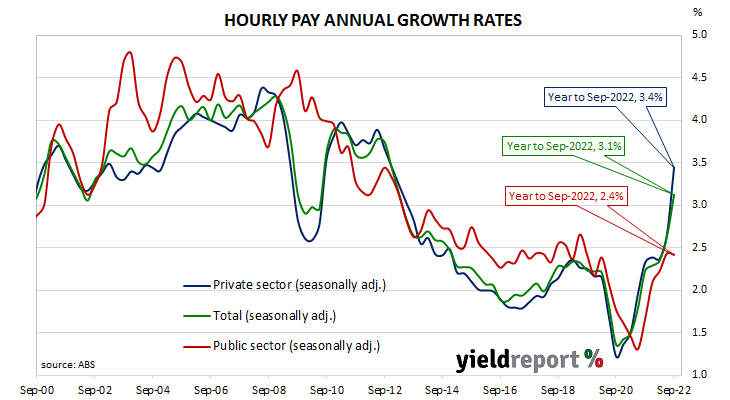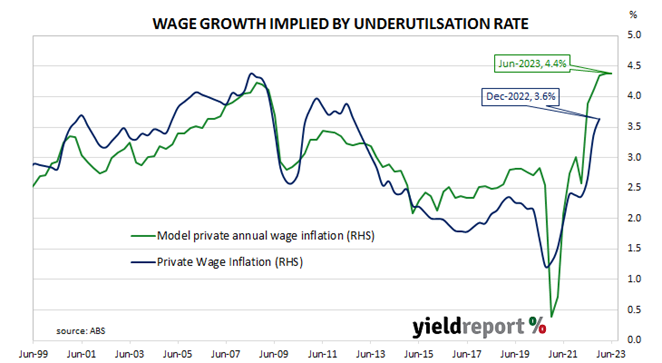Summary: December quarter wages up 0.8%, below expectations; annual growth rate increases from 3.2% to 3.3%; NAB: takes some heat out of risk economy ‘knocked off narrow path’; higher than any December quarter increase in previous decade; ANZ: will not prevent further rate rises: private sector wages up 3.6% over year, public sector up 2.5%; latest underutilisation rate implies higher wage growth.
After unemployment increased and wage growth slowed during the GFC, a resources investment boom prompted a temporary recovery back to nearly 4% per annum. However, from mid-2013 through to the September quarter of 2016, the pace of wage increases slowed, until mid-2017 when it began to slowly creep upwards. After remaining fairly stable at around 2.2% per annum from September 2018 to March 2020, the growth rate slowed significantly in the June and September quarters of 2020 before speeding up in 2021 and 2022.
According to the latest Wage Price Index (WPI) figures published by the Australian Bureau of Statistics (ABS), hourly wages grew by 0.8% in the December quarter. The increase was below expectations of a 1.0% rise as well as the September quarter’s 1.1%. On an annual basis, the growth rate increased from 3.2% after revisions to 3.3%.
“Today’s data will be of some comfort to the RBA, taking some of the heat out of the risk that price wage persistence sees the economy ‘knocked off that narrow path’ to a soft landing,” said NAB economist Taylor Nugent.
Domestic Treasury bond yields increased moderately, lagging the noticeable rises of US Treasury yields overnight. By the close of business, the 3-year ACGB yield had added 2bps to 3.59%, the 10-year yield had gained 6bps to 3.88% while the 20-year yield finished 4bps higher at 4.22%.
In the cash futures market, expectations regarding future rate rises softened. At the end of the day, contracts implied the cash rate would rise from the current rate of 3.33% to average 3.50% in March and then increase to an average of 3.905% in May. August contracts implied a 4.21% average cash while November contracts implied 4.205%.
“While it was a clear step down in the pace of wage inflation the ABS noted that the December increase in hourly wage rates was higher than any December quarter increase in the previous decade,” noted Westpac senior economist Justin Smirk. “This follows on from the September and June 2022 quarter increases which were also higher than their comparable quarters back to 2012.”
Even though ANZ senior economist Catherine Birch essentially agreed with NAB’s Nugent, she thought rate rises are still on the cards. “While today’s print will give the RBA comfort that a price-wage spiral does not appear to be emerging, we don’t think it alone will prevent further rate rises.”
Wages in the private and public sectors grew by 0.8% and 0.7% respectively in the quarter. Over the past 12 months, wages in the private sector increased by 3.6% while public sector wages increased by 2.5%. Annual wage growth in the two sectors had been at 3.4% and 2.4% respectively in the September quarter.
The “underutilisation rate” is simply the sum of the unemployment and underemployment rates as per ABS monthly statistics. It has a good correlation with private wage growth two quarters in the future and thus it is useful as a leading indicator. However, differences can open up from time to time. January’s underutilisation rate suggests private wage growth is likely to continue accelerating.
Each quarter the ABS surveys around 3,000 private and public enterprises regarding a sample of jobs in each workplace to measure changes in the price of labour across 18,000 jobs. The results are used to construct the Wage Price Index in a manner similar to the construction of the Consumer Price Index (CPI). Changes in the WPI over time provide a measure of changes in wages and salaries, independently of the type or quantity of work.



